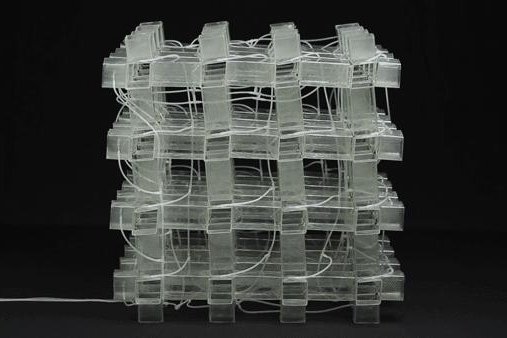1 of 2 | A new versatile, tunable and self actuated material created by Harvard researchers is composed of extruded cubes. Photo by Johannes Overvelde/Harvard SEAS
CAMBRIDGE, Mass., March 11 (UPI) -- Like origami on steroids, a new self-actuated 3D material developed by scientists at Harvard University can do almost anything.
It can fold and unfold, shrink and expand -- all within a matter of seconds. When folded flat, the material can withstand the weight of an elephant.
"We've designed a three-dimensional, thin-walled structure that can be used to make foldable and reprogrammable objects of arbitrary architecture, whose shape, volume and stiffness can be dramatically altered and continuously tuned and controlled," Harvard grad student Johannes T. B. Overvelde explained in a news release.
The material is made of extruded cubes -- cubes with hollowed-out channels, creating a fixed cross-sectional profile with 24 faces and 36 edges. The edges operate like hinges, allowing the cubes to be deformed into a wide variety of shapes.
To create the new 3D material, researchers affixed 64 of the cubed cells. The end result was a cube with a length, width and height of four cells. Scientists came up with the design after studying an origami technique called snapology.
Because the way the cells are folded can change the stiffness of the material, the material can be manipulated to change both shape and strength.
"We not only understand how the material deforms, but also have an actuation approach that harnesses this understanding," said lead researcher Katia Bertoldi, an associate professor of natural sciences at Harvard's John A. Paulson School of Engineering and Applied Sciences. "We know exactly what we need to actuate in order to get the shape we want."
A variety of inputs can be used to instigate a structural change in the material.
"The opportunities to move all of the control systems onboard combined with new actuation systems already being developed for similar origami-like structures really opens up the design space for these easily deployable transformable structures," added James Weaver, a senior research scientist at Harvard's Wyss Institute for Biologically Inspired Engineering.
Researchers say the material can be scaled and could be used to construct something as small as a surgical stent or as large as a portable shelter used for disaster relief.
The materials is detailed in a new paper published this week in the journal Nature Communications.















